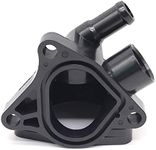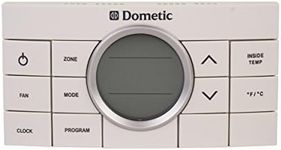Buying Guide for the Best Digital Thermostat For Rv
Choosing the right digital thermostat for your RV is crucial for maintaining a comfortable environment while on the road. A good thermostat will help you regulate the temperature efficiently, ensuring that your RV stays cozy in the winter and cool in the summer. When selecting a digital thermostat, consider the following key specifications to find the best fit for your needs.CompatibilityCompatibility refers to whether the thermostat can work with your RV's heating and cooling systems. This is important because not all thermostats are designed to work with all types of HVAC systems. To navigate this, check your RV's HVAC system type (e.g., single-stage, multi-stage, heat pump) and ensure the thermostat supports it. If you have a basic system, a simple compatible thermostat will suffice. For more complex systems, look for a thermostat that can handle multiple stages or heat pumps. Your need for compatibility will depend on your RV's existing setup.
ProgrammabilityProgrammability allows you to set different temperatures for different times of the day or week. This is important for energy efficiency and comfort, as it lets you automatically adjust the temperature based on your schedule. Thermostats can range from non-programmable, which are simple and easy to use, to fully programmable models that offer daily or weekly schedules. If you have a predictable routine, a programmable thermostat can save energy and maintain comfort. If your schedule varies, a non-programmable or manually adjustable thermostat might be more suitable.
Display and InterfaceThe display and interface refer to how you interact with the thermostat. This is important for ease of use and readability. Displays can range from basic LCD screens to more advanced touchscreens. A clear, easy-to-read display with intuitive controls can make adjusting the temperature simpler, especially in low light conditions. If you prefer straightforward controls, a basic display will do. If you like more advanced features and easier navigation, consider a touchscreen interface. Your preference for simplicity or advanced features will guide your choice here.
Power SourceThe power source is how the thermostat gets its energy to operate. This is important because it affects installation and reliability. Thermostats can be battery-powered, hardwired, or use a combination of both. Battery-powered models are easier to install but require regular battery changes. Hardwired models are more reliable but may need professional installation. If you prefer a simple setup, a battery-powered thermostat is ideal. If you want a more permanent solution with less maintenance, a hardwired model is better. Your preference for ease of installation versus long-term reliability will help you decide.
Wi-Fi ConnectivityWi-Fi connectivity allows you to control the thermostat remotely using a smartphone app. This is important for convenience and advanced control. Wi-Fi-enabled thermostats can be adjusted from anywhere, providing flexibility and the ability to monitor your RV's temperature even when you're not there. If you value remote control and smart home integration, a Wi-Fi-enabled thermostat is a great choice. If you prefer a simpler, more traditional approach, a non-Wi-Fi model will suffice. Your need for remote access and smart features will determine the importance of this spec.
Temperature RangeThe temperature range is the span of temperatures the thermostat can control. This is important for ensuring the thermostat can handle the extremes you might encounter. Different thermostats have different ranges, so check the minimum and maximum temperatures they support. If you travel to areas with extreme temperatures, choose a thermostat with a wide range. If you stay in moderate climates, a standard range will be sufficient. Your travel destinations and climate conditions will guide your choice here.




















